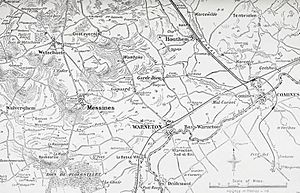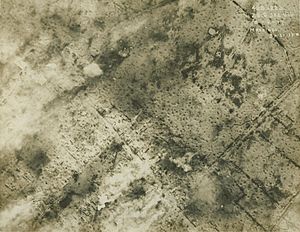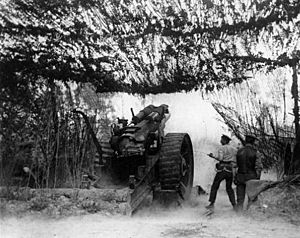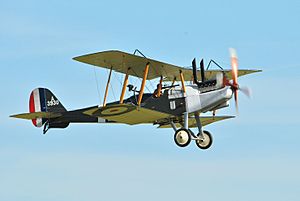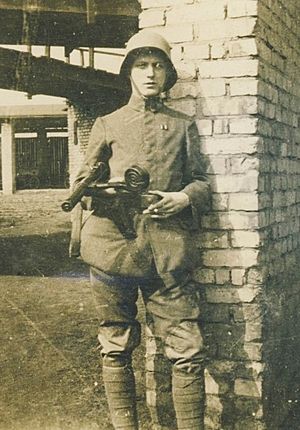Capture of Wytschaete facts for kids
Quick facts for kids Capture of Wytschaete |
|||||||
|---|---|---|---|---|---|---|---|
| Part of the Battle of Messines (1917) of the First World War | |||||||
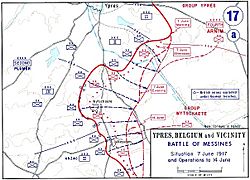 Map of the battle, showing the front on 7 June and operations until 14 June |
|||||||
|
|||||||
| Belligerents | |||||||
| Commanders and leaders | |||||||
| Sir Douglas Haig Sir Herbert Plumer |
Rupprecht, Crown Prince of Bavaria Sixt von Armin |
||||||
| Units involved | |||||||
| IX Corps | Gruppe Wijtschate (XIX (2nd Royal Saxon) Corps) | ||||||
| Strength | |||||||
| 36th (Ulster) Division 16th (Irish) Division |
2nd Division | ||||||
| Casualties and losses | |||||||
| 36th (Ulster) Division: c. 700 16th (Irish) Division: 1,183 (6/7–9 June) |
3,563 | ||||||
The Capture of Wytschaete was an important event during the Battle of Messines (1917) in the First World War. On 7 June 1917, British soldiers attacked the Messines Ridge in Flanders, Belgium. The 36th (Ulster) Division and the 16th (Irish) Division, part of the British IX Corps, captured the village of Wytschaete. This village was a strong fortress on the Messines Ridge. The German 4th Army had held it since 1914.
Before the battle, German commanders thought about moving back from the Messines area. But local commanders disagreed. They felt their defenses were strong. They also believed British attempts to dig tunnels under their lines had failed.
The British attack at Messines involved a secret weapon: huge underground mines. These mines were packed with explosives. They had been dug under German positions since 1915. The plan was to blow them up just before the attack. The IX Corps was to attack the main German strongpoint. They would advance about 3,000 yards (2.7 km) to capture Wytschaete. Soldiers from both the 36th (Ulster) and 16th (Irish) Divisions fought together. They quickly took over the village by 8:00 a.m.
The German 2nd Division was defending Wytschaete. Many of their soldiers were killed or stunned by the mine explosions. Heavy artillery and gas attacks also weakened their defenses. The remaining German defenders could not stop the British tanks and Irish soldiers. The commander of the German forces in the area, Lieutenant-General Maximilian von Laffert, was removed after the battle. Later, a German general said that if they had pulled back earlier, they would have avoided a "worst tragedy."
Contents
Understanding the Battleground
Messines Ridge: A Key Location
Messines Ridge is a chain of low hills in West Flanders, Belgium. It runs around the city of Ypres. Wytschaete is a village located on this ridge. The ridge has a gentle slope on its eastern side. But it has a steeper slope on its western side. South of the ridge is a marshy valley and a wood called Ploegsteert.
In 1917, the villages on the ridge were mostly ruins. But they had been turned into strong defensive positions. The ridge was very important. It blocked access to the Heuvelland district from the Lys valley to the east. Capturing it would give the British a great advantage.
The First Battle for Messines (1914)
The British first took Messines in October 1914. But German troops attacked the ridge soon after. They slowly pushed the British back. By October 31, the Germans had captured Wytschaete. British and French soldiers tried to take it back. They succeeded for a short time. But the Germans recaptured Wytschaete on November 2. This meant the Germans had controlled the ridge for a long time.
The German 4th Army's Defenses
The German 4th Army defended the Western Front in Belgium. By 1917, they held Messines Ridge. Their defenses were very strong. They had spent two years building them. The German positions were on a forward slope. This meant they could be seen by British observers. This was a disadvantage for the Germans.
In early 1917, German commanders thought about pulling back. They knew the British might attack. But local commanders wanted to hold their ground. They believed their defenses were too strong to be broken. They also thought their counter-mining efforts had stopped the British. The Germans had many guns and howitzers ready. They had 344 field guns, 242 medium guns, and 44 heavy guns.
Preparing for the Attack
German Defenses and Morale
German soldiers in the Wytschaete area held wide sections of the front. They had machine-gun posts spread out. Their plan was to quickly counter-attack if the British broke through. The 2nd German Division defended Wytschaete itself. This area was lightly held, but had strongpoints.
British artillery fire became very strong in May 1917. It destroyed many German trenches and concrete shelters. British planes flew over German lines. They helped direct the artillery fire. German soldiers had to move into shell-holes for safety. Their shelters were being destroyed. Many German soldiers felt their positions were undermined. This made their morale low. A captured British soldier even told them about the upcoming mine explosions.
On June 3, British heavy guns and gas shells hit Wytschaete. This caused huge damage. Many German defensive positions in the village were smashed. German planes tried to fight back. But British air superiority was too strong.
British Attack Preparations
The British had been digging tunnels under Messines Ridge since 1916. They dug deep into the ground. Then they placed 26 huge mines. These mines contained 447 tons of explosives. They were meant to blow up the German front line.
The British Second Army planned their artillery attack very carefully. They used new maps and weather data. They wanted to destroy German barbed wire. They also wanted to silence German guns. They used new sound-ranging equipment. This helped them find German gun positions. British artillery fire increased a lot before the attack. They fired millions of shells.
The British also practiced their attack. They built a model of the ridge. Soldiers could see the German defenses on this model. This helped them understand the battleground. They also practiced how to move forward. Communication was very important. They used pigeons, radios, and special phones.
The 16th (Irish) Division trained hard for the attack. They rehearsed over a copy of the Wytschaete area. They also sent out patrols to gather information. These patrols captured German prisoners and documents. This helped them learn about German defenses.
Air Power in the Battle
British aircraft played a big role. They helped direct artillery fire. They also took photos of German positions. About 300 aircraft were used for this. British fighter planes tried to stop German planes. They patrolled the sky to protect British observation planes.
British planes also attacked German targets on the ground. They bombed airfields and railway stations. On the night before the attack, British planes flew low. This helped hide the sound of tanks moving to their starting points. Air observation was crucial for knowing where British troops were. It also helped spot German counter-attacks.
The Battle Begins
IX Corps Attacks
The attack started at 3:10 a.m. on June 7. It was still dark, but visibility was expected to be good. First, the mines exploded. Huge flames and smoke shot into the sky. The ground shook violently. Then, British artillery opened fire. The first wave of soldiers moved forward. They followed a "creeping barrage" of shells. This meant the shells exploded just ahead of them.
36th (Ulster) Division's Advance
The 36th (Ulster) Division faced the Spanbroekmolen mine. This mine exploded a few seconds late. Some soldiers were knocked over. But they quickly got up and kept moving. It was hard to keep direction around the huge craters. But the German defenders were too stunned to resist much.
The German artillery response was weak. It mostly hit empty British trenches. The British soldiers reached their first objective quickly. They paused for 15 minutes. Then, fresh companies moved forward. They continued the advance. German machine-guns tried to fire from woods and farms. But the British soldiers quickly captured these positions. The most difficult German position was at Jump Point. But it also fell quickly. The division reached its second objective by 4:50 a.m.
The advance paused again. Soldiers started to dig in and strengthen their positions. More troops moved forward. They faced some German artillery fire but had few casualties. They continued towards Wytschaete. A tank helped them knock out a German machine-gun. They fought their way through the village. They captured a German headquarters and many prisoners.
16th (Irish) Division's Fight
The 16th (Irish) Division attacked between Maedelstede Farm and the Vierstraat–Wytschaete road. The mines here had destroyed many German defenders. Some mines exploded a bit late. But the soldiers kept going. They moved through Wytschaete Wood. This wood had been heavily bombed before the attack.
The division reached its second objective just after 5:00 a.m. They paused for two hours. Then, at 7:00 a.m., the artillery barrage started again. The infantry followed, with 16 tanks supporting them. A tank drove into Wytschaete village. Soldiers from the Munster Fusiliers and Royal Irish Regiment followed. They quickly took over the ruined village. By 9:30 a.m., Wytschaete was secure.
The supporting battalions moved through the attacking ones. Tanks also moved to the eastern side of the village. The soldiers captured more German positions. They reached their objective on the far side of the Messines–St Eloi road. By 8:00 a.m., the division had captured hundreds of German prisoners.
Air Support During the Battle
As the soldiers attacked, British planes flew overhead. They helped track the positions of British troops. Soldiers would light flares to show their location. This helped the planes guide artillery fire. German planes tried to stop them. But British fighter patrols kept them away.
British planes also attacked German targets on the ground. They shot at German soldiers, vehicles, and machine-gun nests. These attacks continued all day. They helped break up any German counter-attacks. After dark, night-bombing planes attacked German railway stations. This stopped German supplies and reinforcements.
German Defense and Counter-attacks
When the British artillery stopped, German soldiers returned to their front lines. Then the mines exploded. This destroyed most of their defenses. Many German soldiers were killed or stunned. The British quickly overran them. Some German stormtroopers tried to counter-attack. But they were quickly overwhelmed.
Smoke and dust from the British attack made it hard to see. Some German defenders thought the approaching figures were their own soldiers. They were quickly overrun too. The German defense around Messines collapsed. This left other German units exposed. They had to retreat.
German commanders expected their reserve divisions to counter-attack. But these divisions were delayed. They were shelled by British artillery. They also didn't know the area well. By the time they arrived, the British had already taken their objectives. The German counter-attacks failed.
After the Battle
Battle Casualties
The Capture of Wytschaete was a British victory. But it came at a cost. The British IX Corps had about 5,263 casualties. The 36th (Ulster) Division had about 700 casualties. The 16th (Irish) Division had 1,183 casualties. The Germans suffered much more. The German 4th Army had about 22,988 casualties. This included many missing soldiers. One German regiment, Grenadier Regiment 8, lost 1,416 men in one day.
Pushing to the Oosttaverne Line
After capturing Wytschaete, the British paused. They wanted to prepare for the next attack. This was on the Oosttaverne Line. More artillery was brought forward. Machine-guns were set up to fire over the advancing troops. Tanks also moved forward to help.
The British attacked the Oosttaverne Line in the afternoon. The German resistance was light. The British quickly captured this objective. They met Australian soldiers who had advanced from another area. The capture of Wytschaete was a key part of the larger Battle of Messines.
Images for kids
-
Fokker Dr I of Manfred von Richthofen operating over the Messines salient


